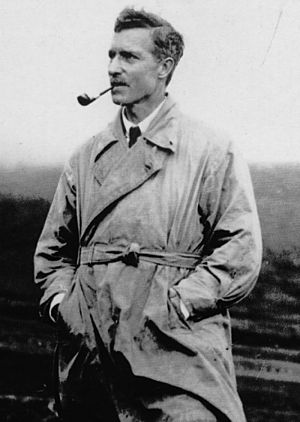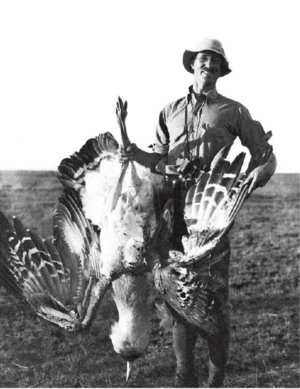Richard Meinertzhagen facts for kids
Quick facts for kids
Richard Meinertzhagen
|
|
|---|---|

Meinertzhagen in 1922
|
|
| Born |
Richard Meinertzhagen
3 March 1878 London, England
|
| Died | 17 June 1967 (aged 89) Swordale, Ross-shire, Scotland
|
| Scientific career | |
| Fields | Zoology Parasitology |
Richard Meinertzhagen (born March 3, 1878 – died June 17, 1967) was a British soldier, intelligence officer, and ornithologist. He had an important military career in Africa and the Middle East. He was known for creating a clever trick called the Haversack Ruse in October 1917 during the Sinai and Palestine Campaign of the First World War. However, later information showed that he might not have been involved in this trick as much as he claimed.
Contents
Early Life and Interests
Richard Meinertzhagen was born into a rich and well-connected British family in London. His father, Daniel Meinertzhagen, led a famous banking family. His mother, Georgina Potter, was the sister of Beatrice Webb, who helped start the London School of Economics.
As a young boy, Richard went to boarding schools like Aysgarth School and Harrow School. He was even at Harrow at the same time as Winston Churchill. When he was 18, he worked for his family's bank in Germany, where he learned German. But he wasn't interested in banking. He later joined the Hampshire Yeomanry, a military group.
Richard loved bird-watching from a young age. His brother Daniel and he were encouraged by family friends like Herbert Spencer and Charles Darwin, who taught them to observe birds. They even had a pet sparrowhawk and met famous bird experts at the Natural History Museum.
Military Adventures
Since banking wasn't for him, Meinertzhagen joined the British Army in 1899. He was sent to India, where he hunted big game. He then asked to be transferred to Africa and arrived in British East Africa (now Kenya) in 1902.
Serving in Africa
In Africa, Meinertzhagen worked as a staff officer with the King's African Rifles (KAR). He was very good at drawing maps and wildlife, showing his artistic talent. He also helped count wild animals in places like the Serengeti.
He is believed to have named Nyeri Town in Kenya after a nearby hill. However, he also had conflicts with local people over taxes. In one event, his soldiers burned villages, leading to the deaths of many people.
Meinertzhagen was involved in military actions against local groups. In 1905, he ended the Nandi Resistance by killing their leader, Koitalel Arap Samoei. Meinertzhagen met Koitalel under the pretense of a meeting but shot him. He claimed it was self-defense. Some items he collected from this time were returned to Kenya in 2006. Because of these events, he was sent back to England in 1906.
After some office jobs, he was sent to South Africa and then Mauritius. By 1913, he was in India.
First World War Service
When the First World War began, Meinertzhagen joined the intelligence staff. He was good at making maps. From 1915 to 1916, he was the chief of British military intelligence in East Africa. He was awarded the Distinguished Service Order for his service.
Palestine Campaign
In 1917, Meinertzhagen was moved to Deir al-Balah in Palestine. He worked with Nili, a Jewish spy network led by Aaron Aaronsohn, to gather information about the Ottoman army.
The 'Haversack Ruse'
Meinertzhagen is often linked to a famous trick called the Haversack Ruse in October 1917. According to his diary, he purposely dropped a bag containing fake British battle plans. The idea was for the Ottoman army to find these plans and believe them, leading to a British victory in the Battle of Beersheba and Gaza.
However, the Ottoman commander, Friedrich Freiherr Kress von Kressenstein, doubted the plans were real. He thought the British were trying to trick him. No big changes were made to the German-Turkish positions, suggesting the trick didn't affect their decisions much.
Later research showed that Meinertzhagen might not have planned or carried out this trick. The idea actually came from Lieutenant Colonel J.D. Belgrave, and another officer, Arthur Neate, was the one who dropped the bag. Because of military rules, Neate couldn't speak up at the time.
Even though Meinertzhagen's role was questioned, his stories about the ruse inspired Winston Churchill to create a special section during the Second World War. This group planned many clever deception operations, like Operation Mincemeat, which helped the Allies win battles.
Work in Zoology

Meinertzhagen was very interested in nature. He took photos, drew pictures, and wrote detailed descriptions of animals and places. He discovered new species of bats, birds, and even bird lice. In 1940, a group of bird lice was named Meinertzhageniella after him. He also became a leader of the British Ornithologists' Club.
Amazing Discoveries
Meinertzhagen became famous when he discovered the Giant forest hog in 1903. He was the first European to find, kill, and prepare a specimen of this animal, which was then named Hylochoerus meinertzhageni after him. He also discovered and named several bird species, like the Afghan snowfinch.
Nicoll's Birds of Egypt
In 1930, he edited a book called Nicoll's Birds of Egypt. His friend Michael J. Nicoll started the book but died before finishing it. Meinertzhagen completed the work, adding his own research and illustrations.
Questions About His Collection
In the 1990s, scientists looked closely at Meinertzhagen's bird collection at the Walter Rothschild Zoological Museum. They found that many of the specimens he claimed to have collected himself actually matched birds that had been reported missing from other collections. This suggested that he might have taken specimens collected by others and claimed them as his own. For example, a rare forest owlet, thought to be extinct, was rediscovered in 1997 after scientists searched in the correct location, not the one Meinertzhagen had falsely claimed.
Personal Life
In 1911, Meinertzhagen married Armorel, but their marriage ended in 1919. In 1921, he married Anne Constance Jackson, who was also an ornithologist. They had three children. Anne sadly died in 1928. Meinertzhagen never remarried.
Legacy
Richard Meinertzhagen's life and actions have been the subject of several books. He was also portrayed in films like The Lighthorsemen (1987) and A Dangerous Man: Lawrence After Arabia (1990).
Published Works
Meinertzhagen wrote many articles for science journals and military reports. Some of the books he wrote or edited include:
- 1930 – Nicoll's Birds of Egypt
- 1947 – The Life of a Boy: Daniel Meinertzhagen, 1925–1944
- 1954 – Birds of Arabia
- 1957 – Kenya Diary 1902–1906
- 1959 – Middle East Diary, 1917–1956
- 1959 – Pirates and Predators. The piratical and predatory habits of birds
- 1960 – Army Diary 1899–1926
- 1964 – Diary of a Black Sheep
Images for kids
-
Meinertzhagen with a Kori bustard in Nairobi (1915).



